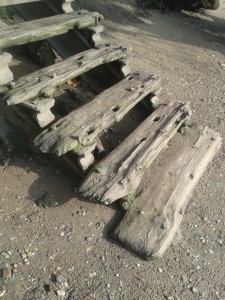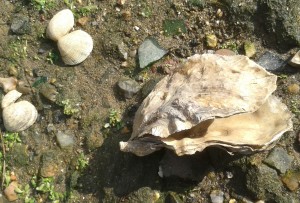In an earlier post, Archaeology: Human Natural History, I wrote about some of the wonderfully rich history that can be gleaned from a walk along the bed of the River Thames at low tide. I delighted in the pottery and pipe-bowls, as I do still.
But today, on a gloriously sunny, still and almost warm day with the tide right out, and the Egyptian Geese honking stridently and flying about — three pairs, and an equally loud loner — my walk along the river produced unexpected and equally delightful results.
Along with a nice potshard of Maling ware (it says “S” “MAL” and half an “H”) , I found an enormous toe-bone of a horse, 95 mm long. It fits snugly in my hand; it’s roughly the size and shape of a pistol grip, and as heavy. It was a proximal phalanx – the sequence is distal (hoof bone) – medial – proximal as you go up the leg. Now, today, one can barely imagine throwing a horse bone into a river. But in the days before public health officers and EU safety regulations, it was nothing strange. For a start, London was full of horses, both fine beasts for gentlemen to ride, or to pull their carriages; and small, tired, sometimes broken-down nags that pulled the rag-and-bone man’s recycling cart, and everything in between. For another thing, people ate horsemeat, as they do today (in decreasing amounts) all across the continent of Europe. If you were poor in Victorian London, horse stew must have been a rich, warm, nutritious and welcome dish: even if the horse had died of old age.

In the soft light, a set of old wooden steps, the timbers worn and scoured by thousands of tides carrying currents of mud, sand, shell and even shingle, were quite beautiful in their natural simplicity, revealing the structure and fibres of the once-thick and rectangular treads.
On the sand a little way further were scatters of Oysters and Cockles, with some other kinds of clam for good measure.

Now at first sight there is nothing very surprising about finding shells in a tidal river: sea shells, sea water. But these are fully marine species: they need salt. And are they not suspiciously fresh? Indeed, they are still articulated. Someone, having enjoyed an excellent seafood dinner, has still, this year, happily thrown out their shells onto the river bed, just as their ancestors did before them through the centuries. The fresh pottery fragments indicate that broken cups, plates (and indeed also pub glasses and bottles) similarly continue to find their way into the the river’s archaeology, just as they have for centuries, if not millennia. The river of life flows on; man’s natural history, his interaction with wild-caught or farmed animals (from horses to horse mussels, perhaps) leaves behind its small detritus of bone and shell, from one generation to the next.
What will the archaeologists of 2,000 years hence make of our generation, our few varves in some long sequence of layers of lake-mud? It is a curious reflection. In the sixties we hoped that it wouldn’t be a plutonium-iridium layer for them to puzzle over. Let’s again hope that it won’t be that.

